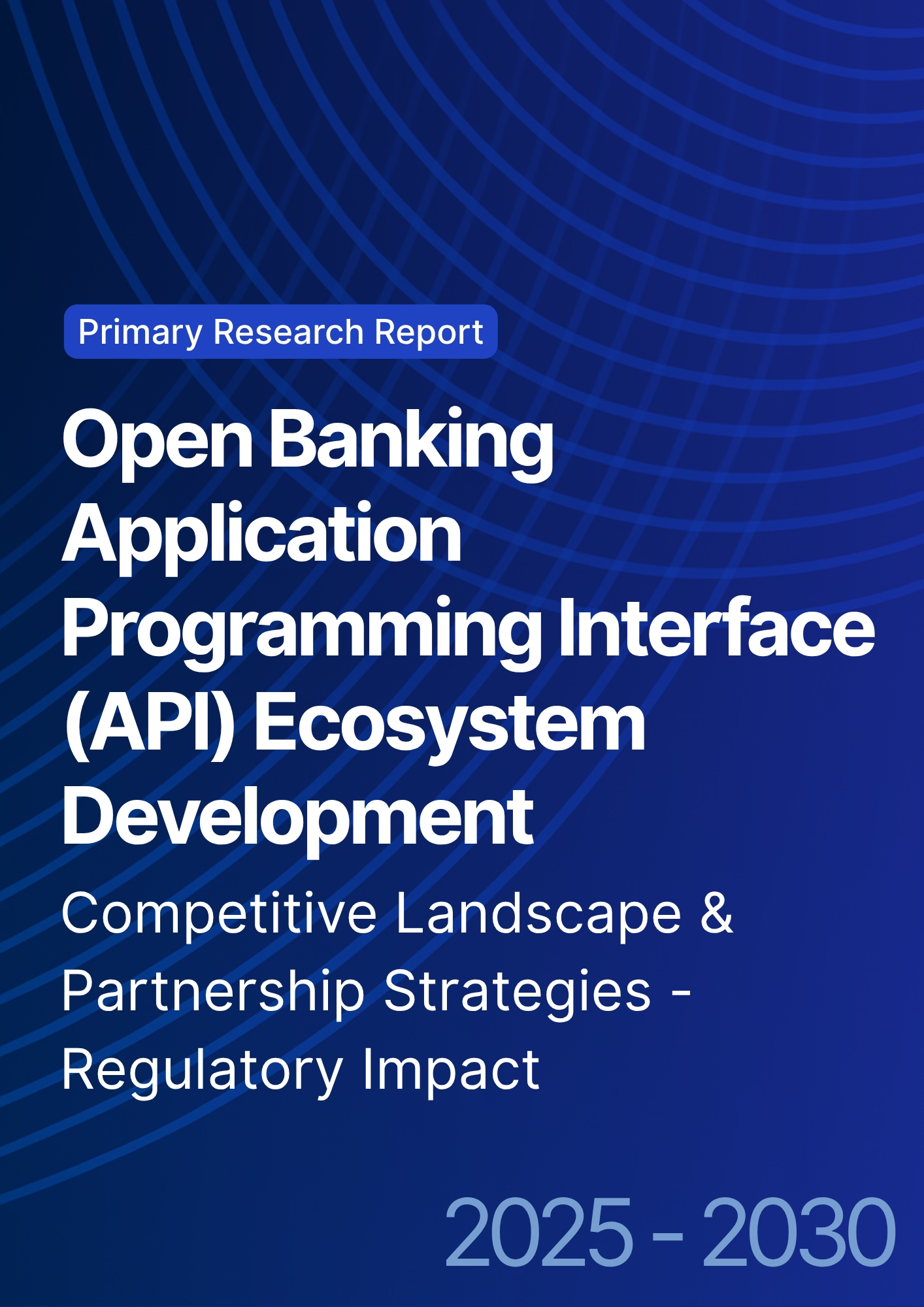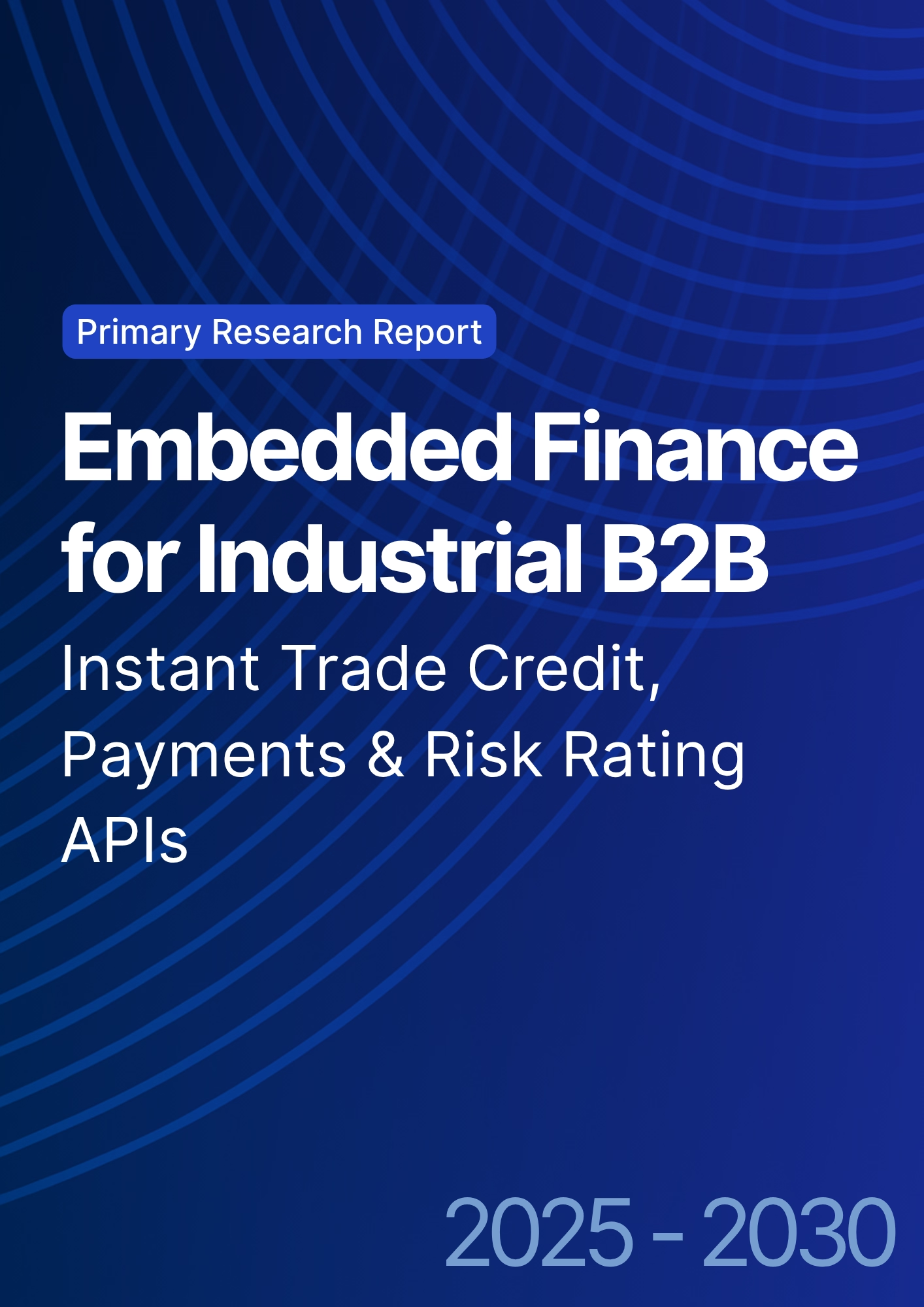

68 Circular Road, #02-01 049422, Singapore
Revenue Tower, Scbd, Jakarta 12190, Indonesia
4th Floor, Pinnacle Business Park, Andheri East, Mumbai, 400093
Cinnabar Hills, Embassy Golf Links Business Park, Bengaluru, Karnataka 560071
Connect With Us
Open Banking Application Programming Interface (API) Ecosystem Development: Competitive Landscape & Partnership Strategies - Regulatory Impact
This research examines the development of Open Banking APIs in India and the Asia Pacific from 2025 to 2030, focusing on ecosystem growth, partnership strategies, and regulatory impacts. The report quantifies adoption rates, API integration trends, and competitive dynamics within the region. By integrating fintech innovations, regulatory frameworks, and key industry players, the study provides actionable insights for financial institutions, fintech companies, and investors seeking to capitalize on the rapidly evolving open banking landscape in Asia Pacific and India.

What's Covered?
Report Summary
Key Takeaways
- Open banking API market in Asia Pacific projected to grow from $1.5 billion in 2025 to $7.6 billion by 2030, CAGR 38%.
- India’s open banking adoption expected to reach 50% of financial institutions by 2030.
- Partnership growth between traditional banks and fintechs to account for 60% of API integration by 2030.
- Regulatory compliance costs in Asia Pacific expected to decrease by 20% with standardized open banking APIs.
- APIs for cross-border payments projected to increase by 30% by 2030, facilitating regional financial integration.
- Consumer adoption of open banking in India projected to rise to 45% by 2030, up from 15% in 2025.
- Fintech partnerships will contribute 40% of new customer acquisition through open banking APIs.
- Data privacy and security regulations are expected to increase compliance costs by 15% in India and Asia Pacific.
- Revenue from API-based financial products projected to grow by 25% annually by 2030.
- API ecosystem maturity will increase interoperability across Asia Pacific, improving financial inclusion.
Key Metrics
Market Size & Share
The Open Banking API market in India and Asia Pacific is projected to grow from $1.5 billion in 2025 to $7.6 billion by 2030, representing a CAGR of 38%. India’s market share in open banking adoption is expected to rise to 50% by 2030, driven by regulatory frameworks such as the India Stack and Pradhan Mantri Jan Dhan Yojana (PMJDY), which enable financial inclusion through API integration. Asia Pacific will see the highest growth in cross-border payment APIs, expected to increase by 30% by 2030, facilitating regional economic integration and easier cross-border financial transactions. Partnership growth between traditional banks and fintechs will account for 60% of API integration by 2030, enhancing product offerings, improving customer acquisition, and expanding service reach. Consumer adoption of open banking is expected to grow from 15% in 2025 to 45% by 2030 in India, as more consumers access services like credit scoring, digital wallets, and personalized financial products. API-based revenue from financial products is expected to grow by 25% annually, driven by subscription-based services, cross-border payments, and tailored wealth management products. As regulatory frameworks mature, institutions will leverage APIs to increase operational efficiency, reduce costs, and improve compliance with data protection laws.
Market Analysis
The open banking API ecosystem in India and Asia Pacific is expanding rapidly, projected to grow from $1.5 billion in 2025 to $7.6 billion by 2030. By 2030, 50% of financial institutions in India are expected to adopt open banking APIs, with 60% of new customer acquisition attributed to partnerships between banks and fintech platforms. These partnerships will allow banks to offer innovative, personalized financial products, such as lending, payments, and wealth management services, that are based on alternative data sources like transaction histories and consumer behavior.
Open banking APIs will significantly reduce regulatory compliance costs by 20% through streamlined KYC and AML processes. Additionally, cross-border payment APIs will increase by 30% as countries within Asia Pacific adopt open banking models and enhance regional financial connectivity. Consumer adoption of open banking in India is expected to rise from 15% in 2025 to 45% by 2030, providing more consumers access to financial services, including digital wallets, personalized credit scoring, and mobile banking solutions. With data privacy regulations in place, the industry will see a 15% increase in compliance costs, as institutions adopt more secure, transparent API integration models. Overall, the market for Open Banking APIs will play a critical role in transforming financial services, driving efficiency, and increasing accessibility for underserved populations.

Trends & Insights
Open banking APIs in India and Asia Pacific are set for transformative growth, projected to expand from $1.5 billion in 2025 to $7.6 billion by 2030, with CAGR of 38%. Key trends include the adoption of APIs for cross-border payments, expected to increase by 30% by 2030, improving regional financial integration and reducing transaction costs. In India, consumer adoption of open banking is anticipated to rise from 15% in 2025 to 45% by 2030, driven by the adoption of digital banking services and regulatory initiatives like the India Stack. Partnerships between traditional banks and fintech firms will account for 60% of new customer acquisition by 2030, facilitating more innovative financial products that leverage alternative data for credit scoring, lending, and payments. Data privacy and security will remain critical concerns, particularly in India, where GDPR-compliant frameworks will influence adoption. Regulatory bodies across Asia Pacific will enhance compliance requirements, reducing compliance costs by 20% as open banking frameworks mature.
By 2030, the API-based revenue from financial products is expected to increase by 25% annually, driven by a more inclusive digital economy, enhanced by AI-powered personalization and innovative partnerships. The API ecosystem’s maturation will improve interoperability, leading to enhanced financial inclusion in underserved markets.
Segment Analysis
The open banking API market in India and Asia Pacific is segmented by institution type, data integration, and technology adoption. Large banks and fintech startups will lead adoption, accounting for 70% of market share by 2030, while mid-tier banks will capture 20%. The remaining 10% will be held by smaller, regional financial institutions. By 2030, 50% of credit institutions will use open banking APIs for lending, payments, and wealth management services, leveraging alternative data to improve decision-making. Partnerships between banks and fintechs are projected to increase by 60%, enabling product innovations, personalized services, and digital-first solutions. Cross-border API adoption is expected to increase by 30%, facilitating real-time payments across Asia Pacific and enhancing financial inclusion in underserved markets.
Data privacy regulations will influence adoption, with 15% additional compliance costs for institutions integrating cross-border API systems. API revenue from financial products is expected to grow by 25% annually, driven by the adoption of open APIs for payments, credit scoring, and consumer banking. Overall, AI-powered systems, alternative data integration, and interoperable APIs will increase bank profitability, improve customer engagement, and drive the widespread adoption of open banking across Asia Pacific by 2030.
.png)
Geography Analysis
The open banking API ecosystem in India and Asia Pacific is projected to experience significant growth, with India representing 30% of total market share in 2025, rising to 35% by 2030 due to increasing adoption of digital banking and financial inclusion efforts. The Asia Pacific region will experience rapid expansion, with cross-border payment API adoption growing by 30% as countries like Singapore, Japan, and Australia increase collaboration. Consumer adoption of open banking in India is expected to rise from 15% in 2025 to 45% by 2030, driven by mobile banking and AI-powered credit scoring.
Data privacy regulations such as GDPR will limit adoption in some countries by 15%, influencing how banks and fintechs collect, store, and share data. By 2030, cross-border APIs will improve transaction speed and cost efficiency, allowing financial institutions to offer real-time services. Financial inclusion in underserved markets will increase by 40% due to the adoption of open banking solutions. Regulatory frameworks will mature, creating more standardized APIs, thus increasing cross-border interoperability. Regional adoption will vary, with advanced markets like Japan and Australia leading, while emerging markets in Southeast Asia and India catch up with API adoption rates.
Competitive Landscape
The open banking API competitive landscape in India and Asia Pacific is dynamic, driven by both traditional financial institutions and fintech disruptors. Large banks such as HDFC, ICICI, and Axis Bank in India, and ANZ, Citi, and HSBC in Asia Pacific, will continue to dominate adoption, contributing to 70% of market share by 2030. Fintech companies like Paytm, PhonePe, and Revolut are expected to capture 15–20% of market share, offering personalized financial services and cross-border payment APIs. AI-driven APIs will improve transaction monitoring, credit scoring, and real-time payments, while partnerships between banks and fintechs will account for 60% of new customer acquisition by 2030.
Regulatory compliance will play a critical role in the competitive landscape, with GDPR and open banking regulations in Europe driving standardized API frameworks for data privacy and security. API providers that integrate blockchain and smart contracts will offer more secure and transparent services, gaining a competitive edge. ROI from open banking APIs is projected at 18–22%, with fintechs capturing younger digital-native consumers and large banks offering comprehensive financial ecosystems. The landscape is expected to consolidate with strategic partnerships and cross-border collaborations to offer scalable, interoperable solutions for the evolving open banking market.
.png)
Report Details
Proceed To Buy
Want a More Customized Experience?
- Request a Customized Transcript: Submit your own questions or specify changes. We’ll conduct a new call with the industry expert, covering both the original and your additional questions. You’ll receive an updated report for a small fee over the standard price.
- Request a Direct Call with the Expert: If you prefer a live conversation, we can facilitate a call between you and the expert. After the call, you’ll get the full recording, a verbatim transcript, and continued platform access to query the content and more.


68 Circular Road, #02-01 049422, Singapore
Revenue Tower, Scbd, Jakarta 12190, Indonesia
4th Floor, Pinnacle Business Park, Andheri East, Mumbai, 400093
Cinnabar Hills, Embassy Golf Links Business Park, Bengaluru, Karnataka 560071
Request Custom Transcript
Related Transcripts
$ 1450
$ 1450


68 Circular Road, #02-01 049422, Singapore
Revenue Tower, Scbd, Jakarta 12190, Indonesia
4th Floor, Pinnacle Business Park, Andheri East, Mumbai, 400093
Cinnabar Hills, Embassy Golf Links Business Park, Bengaluru, Karnataka 560071













